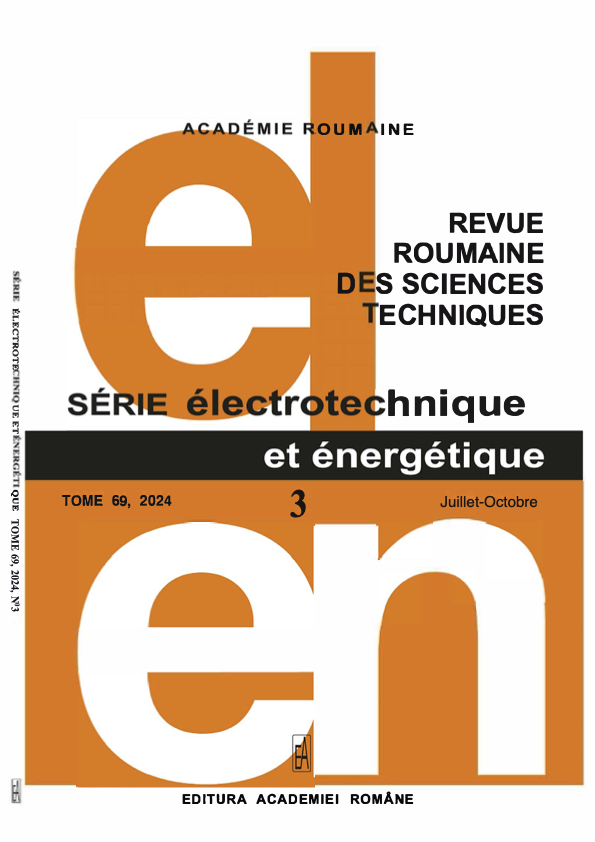DÉVELOPPEMENT ET RÉALISATION D'UN AUDIOMÈTRE AVEC TESTS AUTOMATIQUES ET DIAGNOSTIC INTELLIGENT UTILISANT DES RÉSEAUX NEURONAUX
DOI :
https://doi.org/10.59277/RRST-EE.2024.69.3.19Mots-clés :
Audiomètre, Arduino, Interface utilisateur graphique (GUI) MATLAB, Diagnostic intelligent, Modèle de réseau neuronalRésumé
Un audiomètre est un dispositif médical qui mesure l’état auditif ; la plupart des audiomètres sont destinés à un usage manuel et physique. Le générateur de signal audio génère toutes les fréquences comprises entre 20 Hz et 22 kHz. Ce projet produira un audiomètre tonal (logiciel et matériel) basé sur la carte Arduino avec GUI MATLAB. Ce travail nous a permis de faire le test automatiquement avec un diagnostic intelligent. La partie intelligente est basée sur le modèle de réseau neuronal. Notre travail comprend une carte électronique et trois parties ou interfaces : Interface 1 : gestion du sujet, Interface 2 : test auditif et Interface 3 : audiogramme. Les tests et résultats du prototype sont très satisfaisants ; c'est un signe positif que le prototype fonctionne comme prévu et constitue une solution viable.
Références
(1) B.A. Adekola et al., Hearing loss, gait and balance impairments and falls among individuals with sub-acute stroke: A comparative cross-sectional study, Heliyon, 10, 5 (2024).
(2) M. Haile Lydia et al., Hearing loss prevalence and years lived with disability, 1990–2019: findings from the Global Burden of Disease Study 2019, The Lancet, 397, 10278, pp. 996–1009 (2021).
(3) ***https://en.wikipedia.org/wiki/Sound, Accessed on 18.05.2024.
(4) ***World Health Organization, Deafness and Hearing Loss, Newsroom fact sheets, WHO. 2021, Accessed 15 May 2021.
(5) D. Lammers et al., iHear: Canadian medical student based hearing assessment program for grade school children using a tablet audiometer, Journal of Otolaryngology-Head & Neck Surgery, 50, 1, pp 50–60 (2021).
(6) K. Chung, Alternative audiometric calibration methods: Evaluation of sound level measuring apps for audiometric calibration. Journal of Communication Disorders, 105, 106351 (2023).
(7) K. Hopping, A. Lata Krishnan, Tablet audiometry: Comparison of automated game-based and tester-assisted procedures in children, International Journal of Pediatric Otorhinolaryngology 152, 111006 (2022).
(8) M.T. El-Basheer, Study on audiometer calibration at the extended high-frequency range 8–16 kHz, Noise & Vibration Worldwide, 53,1-2, pp. 24-37 (2022).
(9) O. Hülya, D.H. Turan, K.A. Arzu, The effects of music listening time with headphones on hearing thresholds among the young population, The Egyptian Journal of Otolaryngology, 40, 1: 13 (2024).
(10) B. Xiong et al., Missed hearing loss in tinnitus patients with normal audiograms, Hearing research, 384, 107826 (2019).
(11) R.S. Khandpur, Compendium of Biomedical Instrumentation, 3 Volume Set, John Wiley & Sons, (2020).
(12) C. Drugă et al. Designing and Creating a Smart Audiometer Using an Arduino Platform, Acoustics and Vibration of Mechanical Structures—AVMS 2019: Proceedings of the 15th AVMS, Timisoara, Romania, May 30–31, 2019, Springer International Publishing (2021).
(13) B. McPherson, M.M. S. Law, M.S.M. Wong, Hearing screening for school children: comparison of low‐cost, computer‐based and conventional audiometry, Child: Care, health and development, 36, 3, pp. 323-331(2010).
(14) M. Bastianelli et al., Adult validation of a self-administered tablet audiometer, Journal of Otolaryngology-Head & Neck Surgery, pp. 48-59 (2019).
(15) B. Ponnuswamy et al., wind turbine fault modeling and classification using cuckoo-optimized modular neural networks, Rev. Roum. Sci. Techn. – Électrotechn. Et Énerg., 68, 4, pp. 369–374 (2023).
(16) I. Yaichi, A. Semmah, P. Wira, Control of doubly fed induction generator using artificial neural network controller, Rev. Roum. Sci. Techn. – Électrotechn. Et Énerg., 68, 1, pp. 46–51 (2023).
(17) W. Issaadi, S. Issaadi, Influence of the sampling frequency on various maximum power point tracking commands, Rev. Roum. Sci. Techn. – Électrotechn. Et Énerg., 68, 1, pp. 12–17 (2023).
(18) F. Beloucif, A. Boudefel, A. Guerroui, A. Lemzadmi, A. Moussaoui, Artificial neural network prediction parameters of 10% SF6-90% N2 mixture, Rev. Roum. Sci. Techn. – Électrotechn. Et Énerg., 67, 2, pp. 139–144 (2022).
(19) S. M. Ulaganathan, R. Muniraj, R. Vijayanand, D. Devaraj, Novel solar photovoltaic emulation for validating the maximum power point algorithm and power converter, Rev. Roum. Sci. Techn. – Électrotechn. Et Énerg., 68, 4, pp. 407–412 (2023).
(20) G.G. Tolun, Y.A. Kaplan, Development of backpropagation algorithm for estimating solar radiation: a case study in Turkey, Revue Roumaine des Sciences Techniques—série Electrotechnique et Energétique, 68, 3, pp. 313–316 (2023).
(21) ***mathworks.com/discovery/arduino-programming-matlab-simulink.html, Accessed on 18.05.2024.
(22) C. Keskinoğlu, A. Aydin, Audiometer design and test with bone conduction headphones for engineering education, 7th International Zeugma Conference on Scientific Research, pp. 278–284 (2022).
(23) R. Kumar, S.K. Munjal, A. Sharma, M.N. Alam, N.K. Panda, Effect of face masks on speech understanding: a clinical perspective during speech audiometry, Journal of Otology, 17, 3, pp. 140–145 (2022).
Téléchargements
Publiée
Numéro
Rubrique
Licence
(c) Copyright REVUE ROUMAINE DES SCIENCES TECHNIQUES — SÉRIE ÉLECTROTECHNIQUE ET ÉNERGÉTIQUE 2024

Ce travail est disponible sous licence Creative Commons Attribution - Pas d'Utilisation Commerciale - Pas de Modification 4.0 International.


